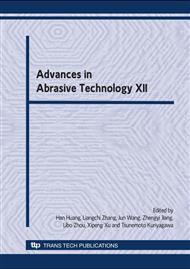p.3
p.9
p.15
p.21
p.27
p.33
p.38
Temperature Fields in Workpieces during Grinding-Hardening with Dry Air and Liquid Nitrogen as the Cooling Media
Abstract:
This paper presents a temperature-dependent finite element heat transfer model, incorporating a triangular moving heat source and various cooling conditions, to predict the three-dimensional temperature field in plunge surface grinding. The model was applied to analyse the grinding-hardening of quenchable steel 1045 using dry air and liquid nitrogen as the cooling media. The temperature field variation under such grinding conditions was also measured experimentally. It was found that the temperature history predicted by the model agrees well with the measured results. The model provides a fundamental study as a first step in optimisation and control of the hardened layer thickness and its compositions in grinding-hardening technology.
Info:
Periodical:
Pages:
3-8
Citation:
Online since:
June 2009
Authors:
Keywords:
Price:
Сopyright:
© 2009 Trans Tech Publications Ltd. All Rights Reserved
Share:
Citation:


